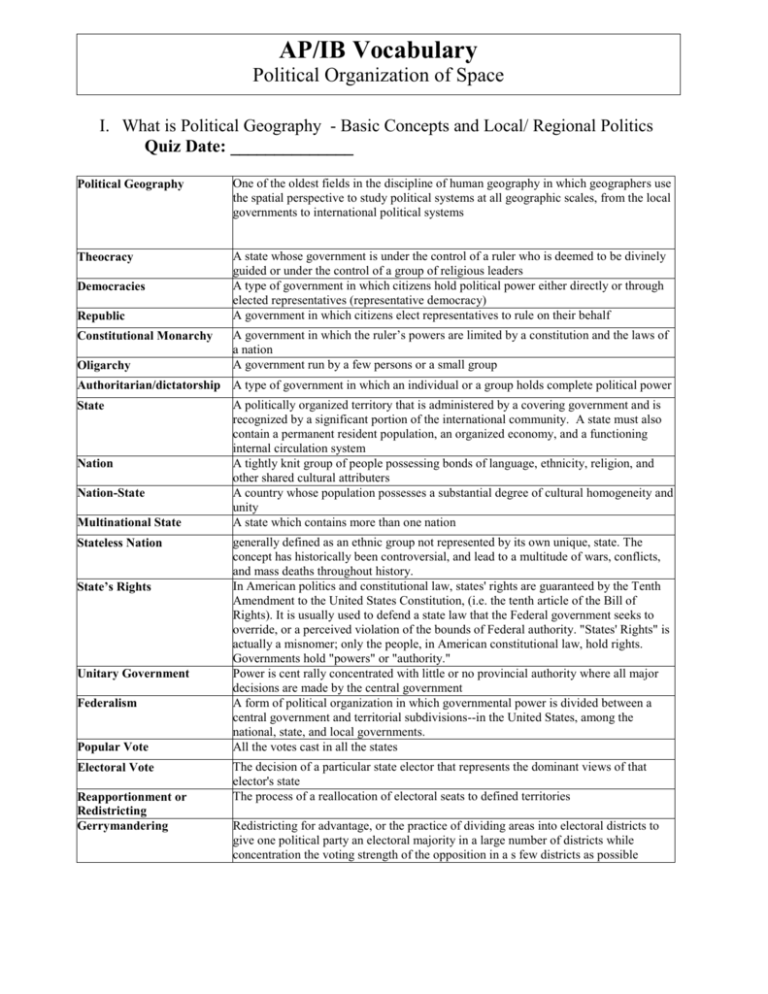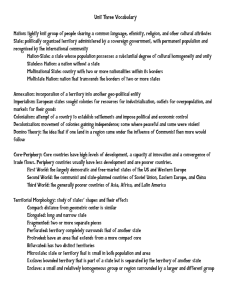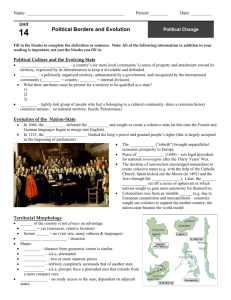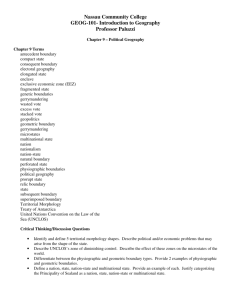AP Vocabulary - Jennifer Arias
advertisement

AP/IB Vocabulary
Political Organization of Space
I. What is Political Geography - Basic Concepts and Local/ Regional Politics
Quiz Date: ______________
Political Geography
One of the oldest fields in the discipline of human geography in which geographers use
the spatial perspective to study political systems at all geographic scales, from the local
governments to international political systems
Theocracy
A state whose government is under the control of a ruler who is deemed to be divinely
guided or under the control of a group of religious leaders
A type of government in which citizens hold political power either directly or through
elected representatives (representative democracy)
A government in which citizens elect representatives to rule on their behalf
Democracies
Republic
Constitutional Monarchy
Oligarchy
A government in which the ruler’s powers are limited by a constitution and the laws of
a nation
A government run by a few persons or a small group
Authoritarian/dictatorship A type of government in which an individual or a group holds complete political power
State
Nation
Nation-State
Multinational State
Stateless Nation
State’s Rights
Unitary Government
Federalism
Popular Vote
Electoral Vote
Reapportionment or
Redistricting
Gerrymandering
A politically organized territory that is administered by a covering government and is
recognized by a significant portion of the international community. A state must also
contain a permanent resident population, an organized economy, and a functioning
internal circulation system
A tightly knit group of people possessing bonds of language, ethnicity, religion, and
other shared cultural attributers
A country whose population possesses a substantial degree of cultural homogeneity and
unity
A state which contains more than one nation
generally defined as an ethnic group not represented by its own unique, state. The
concept has historically been controversial, and lead to a multitude of wars, conflicts,
and mass deaths throughout history.
In American politics and constitutional law, states' rights are guaranteed by the Tenth
Amendment to the United States Constitution, (i.e. the tenth article of the Bill of
Rights). It is usually used to defend a state law that the Federal government seeks to
override, or a perceived violation of the bounds of Federal authority. "States' Rights" is
actually a misnomer; only the people, in American constitutional law, hold rights.
Governments hold "powers" or "authority."
Power is cent rally concentrated with little or no provincial authority where all major
decisions are made by the central government
A form of political organization in which governmental power is divided between a
central government and territorial subdivisions--in the United States, among the
national, state, and local governments.
All the votes cast in all the states
The decision of a particular state elector that represents the dominant views of that
elector's state
The process of a reallocation of electoral seats to defined territories
Redistricting for advantage, or the practice of dividing areas into electoral districts to
give one political party an electoral majority in a large number of districts while
concentration the voting strength of the opposition in a s few districts as possible
II. Territorial Morphology, Boundaries, and Boundary Disputes
Quiz Date: ____________
Microstates
A state or territory that is small in both population and area
Fragmented States
A state whose territory consists of several separated parts, not a contiguous whole. The
individual parts may be isolated from each other by the land area of other states or by
international waters
A state whose territory is decidedly long and narrow in that its length is a least six
times greater than its average width – Chile for example
A political-geographical term to describe a state that possesses a roughly circular, oval,
or rectangular territory in which the distance from the geometric center to any point on
the boundary exhibits little variance. Poland for example
A state whose territory completely surrounds that of another state. South Africa, which
encloses Lesotho and is perforate by it is an example
An interior country or state tat is surrounded by land -- disadvantage in a number of
ways including international trade and access to ocean resources
A type of state territorial shape that exhibits a narrow, elongated land extension leading
away from the main body of territory – Thailand is an example
A piece of territory that is surrounded by another political unit of which it is not a part
Elongated States
Compact States
Perforated States
Landlocked States
Prorupt States
Enclaves
Exclaves
Buffer State
A bounded (non island) piece of territory that is part of a particular state but lies
separated from it by the territory of anther state.
A country or zone separating ideological or political adversaries.
Natural/ Physical
Boundaries
Ethnographic/cultural
Boundaries
Geometric Boundary
Political boundaries that coincide with prominent physical features in the natural
landscape.
Political boundary based on a cultural trait, usually language or religion
Subsequent Boundary
A political boundary that developed contemporaneously with the evolution of the major
elements of the cultural landscape through which it passes.
A political boundary that existed before the cultural landscape emerged and stayed in
place while people moved into occupy the surrounding area. AN example is the 49th
parallel boundary, dividing the United States and Canada between the Pacific ocean
and lake of the Woods in northernmost Minnesota.
A political boundary placed by powerful outsiders on a developed human landscape.
Usually ignores preexisting cultural-spatial patterns. such as the border that now
divides North and South Korea.
A political boundary that has ceased to function but the imprint of which can still be
detected on the cultural landscape
In political geography, the written legal description (in treaty like document) of a
boundary between two countries or territories
In political geography, the translation of the written terms of boundary treaty into an
official cartographic representation
In political geography, the actual placing of a political boundary on the landscape by
means of barriers, fences, walls, or other markers.
Zone of advanced penetration, usually of contention an area not yet fully infiltrated into
a politically organized area
The United Nations Convention on the Law of the Sea (UNCLOS), signed by 157
states (not including the US) in 1982, established state’s rights and responsibilities
concerning the ownership and use of the Earth’s seas and ocean and their resources
The system of drawing a political boundary midway between two states’ coastlines
within the territorial seas or EEZ are narrower than twice the standard or adopted limit
Treaty ports were port cities opened by unequal treaties in China, Japan and Korea. The
first five treaty ports were set up by Nanjing Treaty in 1842. The second group was set
up following the Arrow War ended in 1860 and eventually more than 80 treaty ports
were established in China. The term today includes any ports that are opened through
international treaties
Antecedent Boundary
Superimposed Boundary
Relic
Definition
Delimitation
Demarcation
Frontier
Law of the Seas
Median-line principle
Treaty Ports
Political boundaries defined and delimitated as straight lines or arcs
EEZ (Exclusive Economic
Zones)
Definitional Boundary
Disputes
Locational Boundary
Disputes
Operational Boundary
Dispute
Allocational Boundary
Dispute
An oceanic zone extending up to 200 nautical miles from a shoreline, within which the
coastal state can control fishing, mineral exploration, and additional activities by all
other countries.
The dispute between countries based on the legal description (in a treaty like document)
of a boundary or territory
A dispute that centers on the delimitation and possibly the demarcation of the border.
The definition is not in dispute, but its interpretation. Saudi Arabia and Yemen border
an example
The dispute that involves neighbors who differ over the way their boundary should
function. EX: one state wants to limit migration, but the other state does not.
Smuggling, or nomadic life ways can also lead t conflict
The dispute over natural resources, such as the location of oil off-shore, or the amount
of water taken out of rivers shared by multiple countries
III. Forces That Affect States
Quiz Date: _______________
Balkanization
The fragmentation of a region into smaller, often hostile political units. The term
comes from the example of Yugoslavia and it devolved in the 1990s
The territory created in the Canadian North on April 1, 1999 when the former
Nunavut
Northwest Territories was divided in two. Nunavut means “our land” in Inuktitut
language. Inuit, whose ancestors inhabited these lands for thousands of years, make up
85 percent of the population of Nunavut.
Region caught between stronger, colliding external cultural-political forces, under
Shatterbelt
persistent stress and often fragmented by aggressive rivals. Eastern Europe an
Southeast Asia are classic examples
The belief that people should be loyal to their nations, the people with whom they share
Nationalism
land, culture, and history
Rule by an autonomous power over a subordinate and alien people and place.
Colonialism
Although often established and maintained through political structures, colonialism
also creates unequal cultural and economic relations. Because of the magnitude and
impact of the European colonial project of the last few centuries, the term is generally
understood to refer to that particular colonial endeavor
Conference of Berlin (1884) The Berlin Conference of 1884–85 regulated European colonization and trade in
Africa. Its outcome, the General Act of the Berlin Conference, is often seen as the
formalization of the Scramble for Africa (carving of Africa by European powers). In
German it is referred to as Kongokonferenz ("Congo Conference").
The situation in which one country exerts cultural or economic dominance over another
Imperialism
without the aid of official government institutions
The right of a nation to govern itself autonomously
Self-determinism
Irredentism
Annexation
A policy of cultural extension and potential political expansion aimed at a national
group living in a neighboring country
the formal act of acquiring something (especially territory) by conquest or occupation;
"the French annexation of Madagascar as a colony in 1896"; "a protectorate has
frequently been a first step to annexation"
IV.
International Political Geography
Quiz Date: _______________
International Organization An alliance of two or more countries seeking cooperation with each other without
giving up either’s autonomy or self-determination
A military alliance that joined together to protect member states from the Soviet Union
NATO (North Atlantic
Treaty Organization)
OPEC (Organization of
Petroleum Exporting
Countries)
Confederation
Domino Theory
Iron Curtain
An international economic organization whose member countries all have a single thing
in common -- oil
A form of an international organization that brings several autonomous states together
for a common purpose.
The belief that political destabilization in one country can result in the collapse of order
in a neighboring state, starting a chain reaction of collapse.
The former division between the Communist nations of Eastern Europe {"The Eastern
bloc"}, and the non-Communist nations of Western Europe. The term refers to the
isolation that the Soviet Union imposed on its satellites in the Eastern bloc.








